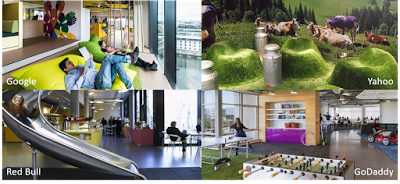Guest Post by Nigel Oseland, Workplace Unlimited

This blog is based on the presentation I gave at the Workplace Trends conference last week, which in turn was based on a presentation I gave at an Innovation Exchange in Lisbon. The room was full of scientists presenting their latest inventions and chemical formulas, and they asked me to present on how the workplace design could assist them. Well I’m always up for a challenge and an all-expenses paid trip to Portugal.
The subject of creativity and innovation is much broader than advances in science. In the UK, we have a tendency to lead in new economic eras only to lose our edge to overseas copycats. It happened with the secondary economic sector, manufacturing like automotive, and it has happened more recently with the tertiary service industry. But we have entered a new quaternary economic age, that of innovation, and as workplace specialists one of our most important jobs is to facilitate innovation and creativity in our workforce. Innovation doesn’t just apply to the creative industries – having a good idea applies to all areas for example creating more efficient process or better customer service as well as new products.
When reading around the subject I found lots of research on creativity. However, it was mostly reported in the business management literature (check out Ideo’s recent survey) or in neuroscience research papers. There was relatively very little on environmental impact. So, does this mean workplace design is considered not important or just not considered?
These spaces, above, are clearly innovative workplaces but are they spaces that foster innovation? Do slides, bean bags, games, grassy seats or trampolines result in higher creativity? Well possibly, a little, but I think innovation starts with people – psychology and culture, rather than with design gimmicks … Read More
